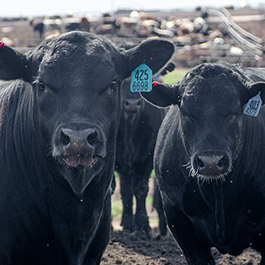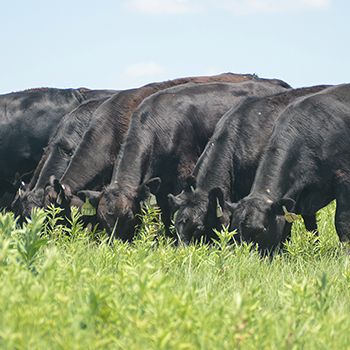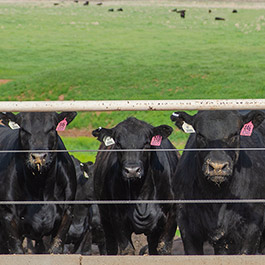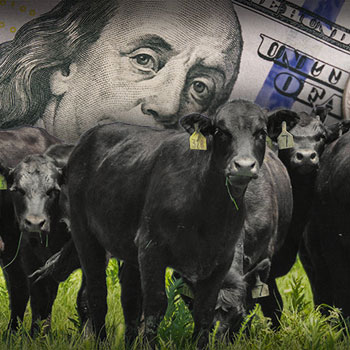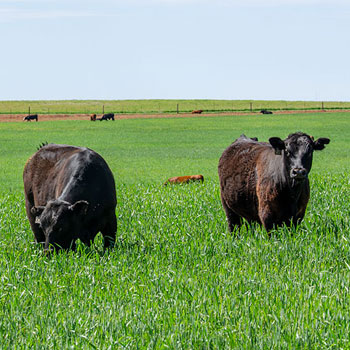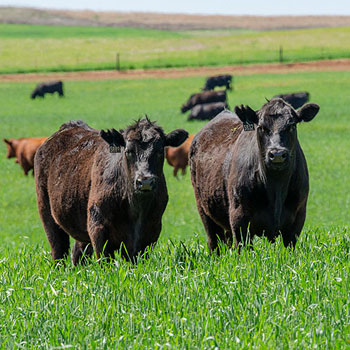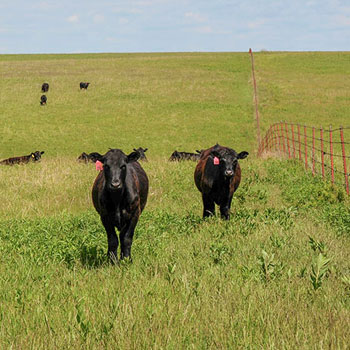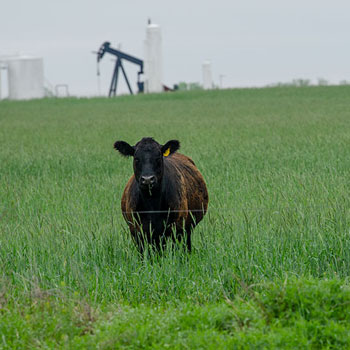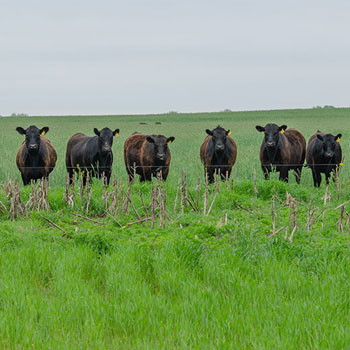
Intranasal vs. Injectable Respiratory Vaccines
Choose the right product at the right time for young calves.
Bovine respiratory disease (BRD) is still a major cause of sickness and death in young beef and dairy calves. While vaccination remains one of the most effective ways to prevent losses associated with BRD, it’s often assumed that intranasal vaccines are the best approach in younger calves. However, recent research shows that previous perceptions about injectable respiratory vaccines may not be accurate, and both types of vaccines have a place in BRD prevention.
Building calf immunity
When a calf is born, its immune system isn’t fully developed. Since it has no antibodies in the blood to fight off pathogens or disease-causing viruses and bacteria, the calf relies on antibodies it receives from the dam via colostrum in the hours after birth.
These maternal antibodies bind to specific pathogens and destroy them, but they’re generally short-lived, gradually waning over the first few months of the calf’s life.
Vaccines are needed to stimulate the calf’s immune system to start producing its own antibodies against specific disease-causing agents. Immunoglobulin A (AIgA) antibodies, thought to be stimulated by intranasal vaccines, are the predominant antibodies in the mucosa, or the lining of organs such as the upper respiratory tract (nasal passages).
Immunoglobulin G (IgG) antibodies, on the other hand, are the predominant antibodies circulating in the blood and are generally believed to be produced in response to injectable vaccines. IgG antibodies help build long-term immunity. Both IgA and IgG antibodies are needed to fight off disease-causing agents.
The role of respiratory vaccines
To help stimulate calf immunity, vaccines expose the animal to antigens, or weakened versions of the pathogens, priming the immune system to create antibodies and other immune cells that will recognize the real pathogens should they invade.
The trouble is, it’s difficult to predict when, exactly, maternal antibodies will diminish from one calf to the next. Maternal antibodies have the potential to recognize vaccine antigens as foreign and neutralize them, which is why vaccines are often not recommended until the calf is a few months old. However, it’s now clear that some, but not all vaccines, are able to override maternal antibodies and stimulate a robust and lasting immunity at an earlier age.
Intranasal vaccines and mucosal immunity
Many beef and dairy producers have turned to intranasal vaccines to boost newborn-calf immunity. These vaccines mimic a natural infection by introducing antigens into the tissue lining the nasal cavities, or mucosa, where respiratory viruses and bacteria typically enter. The idea is to help the body fend off respiratory pathogens in the nasal passages and trachea before they can enter the lungs and really cause damage.
“Intranasal vaccines are generally easy for a newborn calf’s immune system to process,” explains Mike Nichols, technical veterinarian for Boehringer Ingelheim. “These vaccines are able to override maternal antibody interference to create fast, local, mucosal immunity in very young calves.”
In addition to stimulating the production of local IgA antibodies against specific respiratory viruses, intranasal vaccines also spark the production of interferon, or proteins that signal the immune system to increase antiviral defenses in a calf’s body.
At the same time, it’s important to generate cell-mediated immunity, or the production of immune cells that destroy pathogens that have invaded other cells.
“Although some intranasal vaccines may elicit a cell-mediated immune response, it’s typically not as robust or long-lasting as what occurs with injectable vaccines,” reports Nichols. “If you start with an intranasal vaccine in newborn calves, at about 1 to 2 months of age it’s important to stimulate the kind of strong, long-term systemic immunity that’s only possible with injectable vaccines.”
Injectable respiratory vaccines also protect calves against important pathogens not covered by intranasal vaccines, such as bovine viral diarrhea virus (BVDV) Type 1b, the most prevalent BVDV strain in the United States today.
Injectable vaccines can override maternal antibodies
Even at 1 or 2 months of age, most calves still have maternal antibodies in their systems. In the past, it was believed there was no point in giving injectable respiratory vaccines before about 4 months of age because they would be inactivated by maternal antibodies. But a recent study proves that’s not the case.
In the study, calves with maternal-derived immunity for bovine respiratory syncytial virus (BRSV) were administered an injectable modified-live virus (MLV) respiratory vaccine for BRSV or a placebo at 30 days of age. The calves were then exposed to BRSV about 90 days later. Compared to calves that received a placebo, those administered the vaccine had fewer clinical signs and lung lesions, as well as less viral shedding.
These findings prove an injectable respiratory vaccine, when given to calves at 30 days of age, can overcome maternal antibodies to stimulate protective immunity against BRSV.
“That’s not to say all injectable vaccines can do this,” Nichols says. “This particular product utilizes a unique adjuvant that protects vaccine antigens from maternal antibodies, thus enhancing the immune response, even in calves still maintaining high levels of maternal antibodies acquired from colostrum.”
Injectable vaccines stimulate mucosal and systemic immunity
It was previously assumed that intranasal vaccines generated mucosal immunity with IgA antibodies and interferons, while injectable vaccines were responsible for systemic immunity with IgG antibodies. Again, it’s not that cut and dried.
The BRSV study found that calves administered the injectable vaccine developed an IgA mucosal immunity to BRSV, as measured by antibodies in nasal secretions. Vaccinated calves also had significantly higher interferon levels than their unvaccinated counterparts. In addition, they developed a systemic, cell-mediated immunity.
“We now know we don’t have to give intranasal vaccines in order to stimulate the production of IgA antibodies and interferons in the mucosa,” clarifies Nichols.
Injectable vaccines stimulate a rapid immune response, too
Until recently, it was believed that intranasal vaccines stimulated faster immunity than injectable vaccines. But a recent study shows that injectable vaccines can produce rapid immunity, too.
In a study of calves not previously vaccinated against bovine herpesvirus-1 (BHV-1), the causative agent behind infectious bovine rhinotracheitis (IBR), a single dose of a modified-live injectable vaccine containing that antigen produced adequate immunity within three to four days, about the same amount of time required for intranasal vaccines.
A place for both types of vaccines
“Intranasal vaccines are most beneficial for newborn beef or dairy calves that are likely to be exposed to respiratory pathogens early,” Nichols suggests. “Examples would be dairy calves that may benefit from vaccination the day of birth or beef operations that are involved in intensive embryo transfer (ET) or artificial insemination (AI) work resulting in greater disease challenge in the first month or so following birth.”
Following up with an injectable vaccine at 30-60 days of age (preweaning for dairy calves and turnout for beef calves) could then provide broader, more long-lasting immunity.
There are some cases in which calves simply may not need intranasal respiratory vaccination at birth.
“For most beef operations, calves are out on the range,” says Nichols. “If they’ve had good passive antibody transfer from their dams, they may actually be fine until 30 to 60 days of age, when an injectable vaccine could stimulate both the mucosal immune system for local protection, as well as the systemic immune system for robust, long-lasting respiratory disease protection.”
Every herd is different, so remember to consult a veterinarian to develop the most effective protocols for your operation.
Editor’s note: This article is provided by Boehringer Ingelheim. Photo by Brenna Bartlow, NJAA/Angus Journal Photography Contest.

